
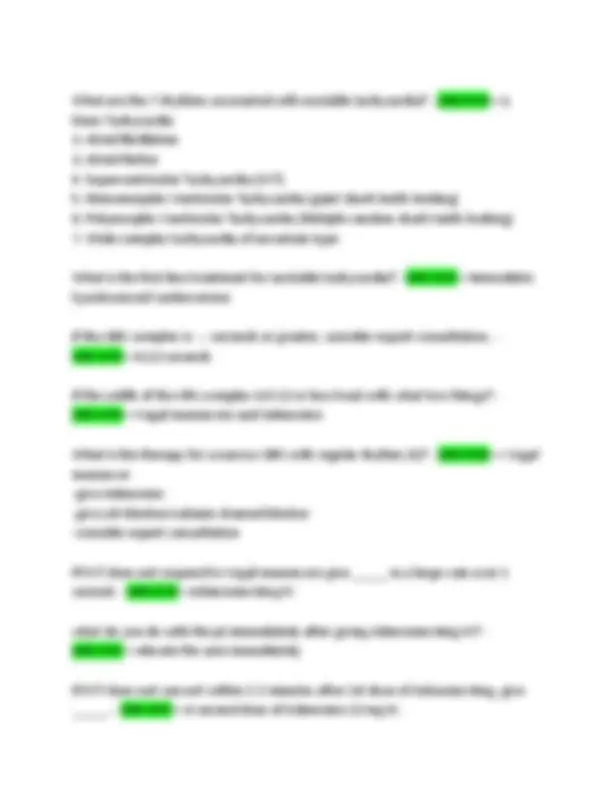
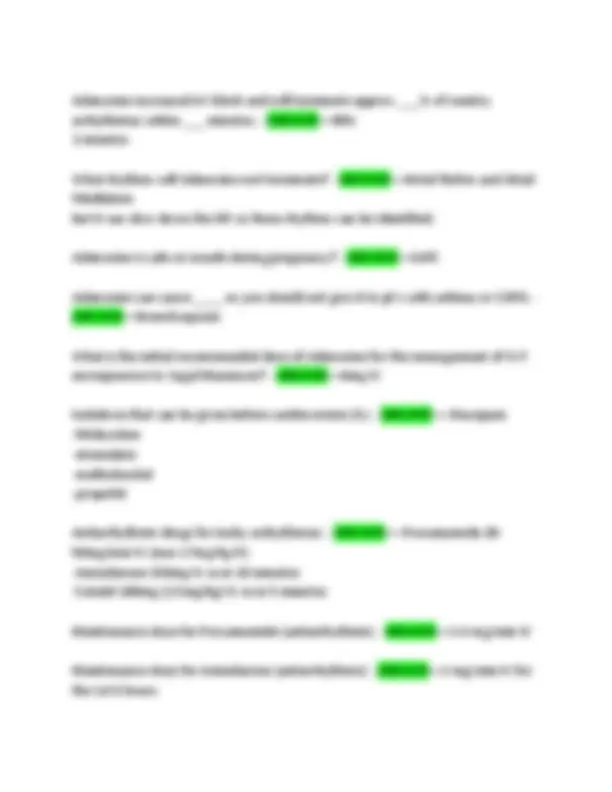
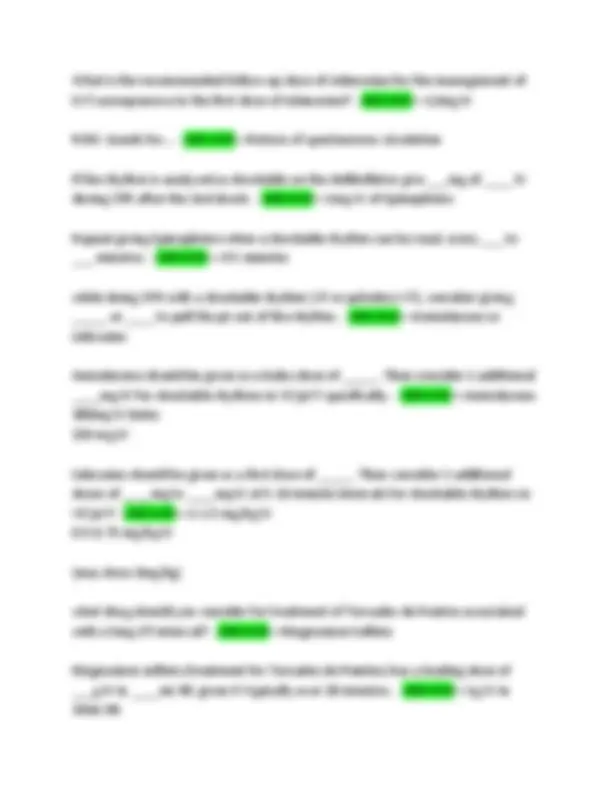
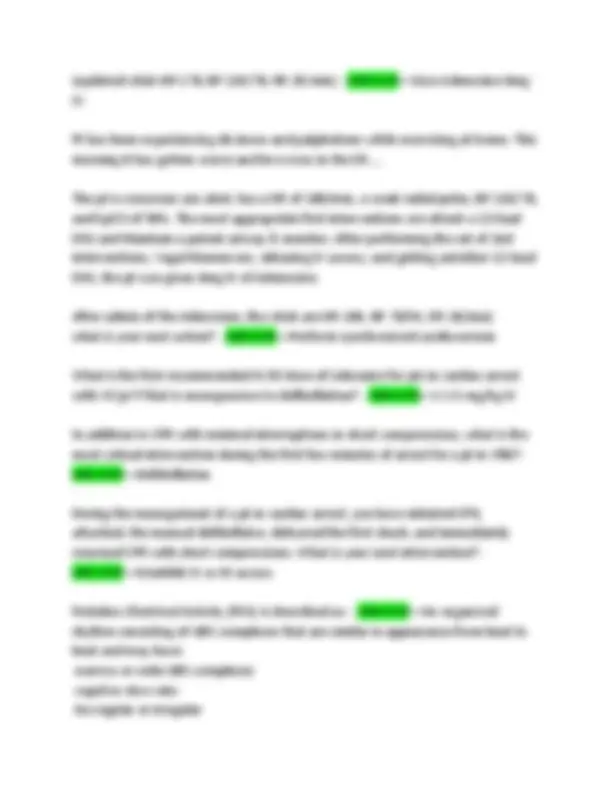
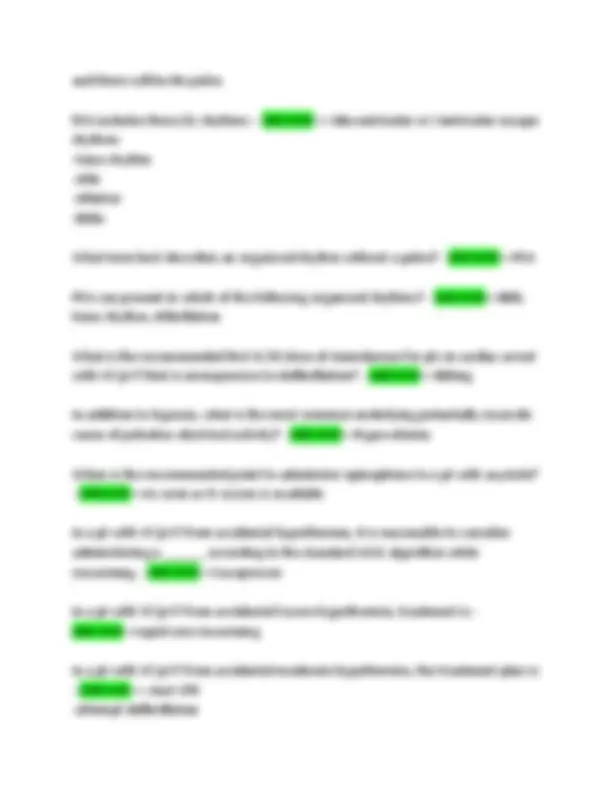
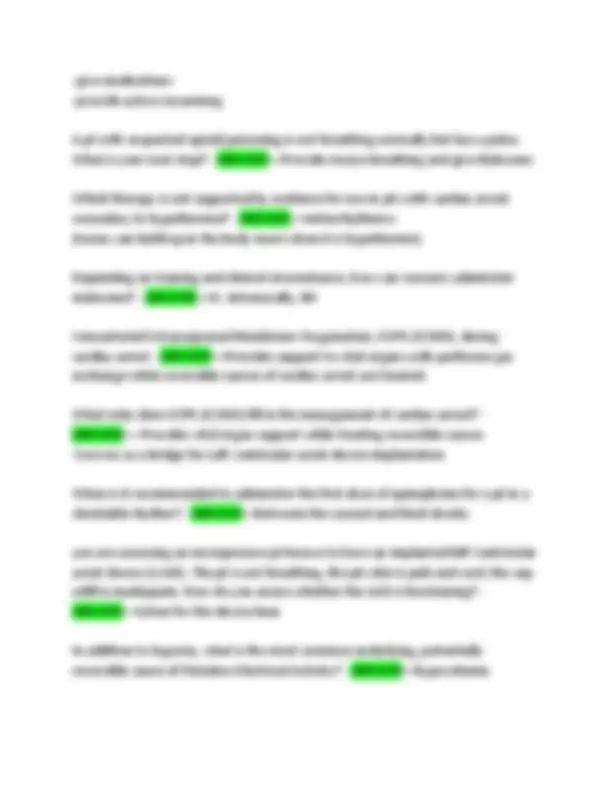
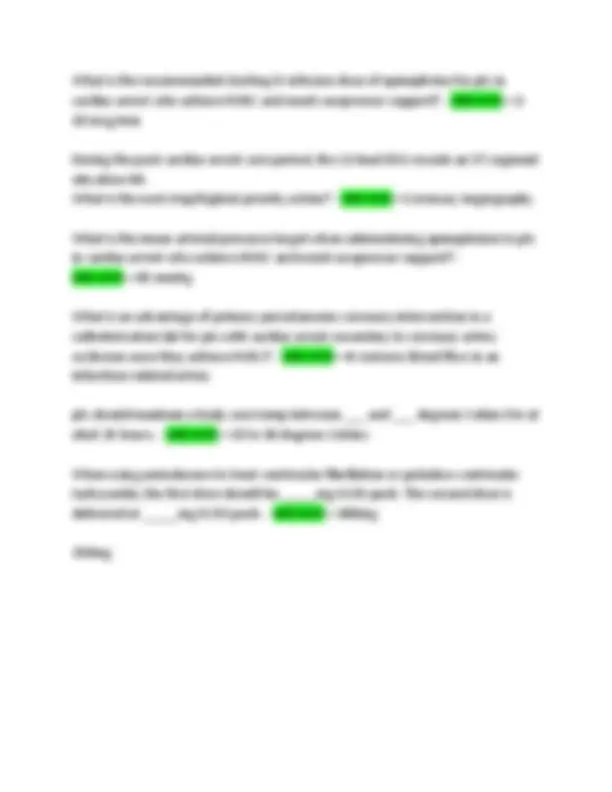


Study with the several resources on Docsity

Earn points by helping other students or get them with a premium plan


Prepare for your exams
Study with the several resources on Docsity

Earn points to download
Earn points by helping other students or get them with a premium plan
Community
Ask the community for help and clear up your study doubts
Discover the best universities in your country according to Docsity users
Free resources
Download our free guides on studying techniques, anxiety management strategies, and thesis advice from Docsity tutors
ACLS Drugs Dosages EXAM QUESTIONS WITH VERIFIED ANSWERS
Typology: Exams
1 / 13

This page cannot be seen from the preview
Don't miss anything!








For poor perfusion with Bradycardia Treat with which first line treatment? - ANSWER>>Atropine 1mg IV (repeat to a total of 3mg IV)
For poor perfusion with Bradycardia Treat, if the first line of treatment is ineffective, what should be provided and what med should be given? - ANSWER>>Transcutaneous pacing
Dopamine 5-20mcg/kg/minute infusion OR Epinephrine 2-10mcg/min infusion
What is the first line drug for acute stable bradycardia and how do you administer it? - ANSWER>>Atropine given as 1mg IV q 3-5minutes (up to 3mg IV)
Hoe does Atropine work? - ANSWER>>Reverses the cholinergic-mediated decreases in the heart rate and AV node conduction
Which two AV block types will not respond to Atropine? - ANSWER>>Mobitz type II second-degree AV block and third-degree AV block
What is the preferred treatment for Mobitz type II second-degree AV block and third-degree AV block? - ANSWER>>TCP or B-adrenergic (dopamine, epinephrine) support until transcutaneous pacing can be achieved
If only 0.5mg of IV Atropine is given what consequence could it have? - ANSWER>>It can further lower the HR
What can be used if bradycardia is unresponsive to Atropine? - ANSWER>>B- adrenergic infusions (dopamine or epinephrine)
What must you consider before giving B-adrenergic infusions in bradycardia? - ANSWER>>The pt's BP/intravascular volume status for hypovolemia
What can be given for bradycardia when vasoconstriction is not desired? - ANSWER>>Dobutamine (b-adrenergic agonist)
Epinephrine should be given at what dose/rate for Bradycardia? - ANSWER>>2- 10mcg/min
Dopamine should be given at what dose/rate for Bradycardia? - ANSWER>>5- 20mcg/kg/min
How does Transcutaneous Pacing (TCP) work and when should it be used? - ANSWER>>It delivers pacing impulses to the heart through skin via cutaneous electrodes.
for unstable bradycardia (hypotension, AMS, shock, ischemic chest pain)
For light sedation within the RN scope of practice give which 3 things should be given before TCP if the pt's condition allows for it? - ANSWER>>-Parenteral narcotic -Parenteral benzodiazepine -Chronotropic infusion
How much of a safety margin (energy above the dose at which consistent capture is observed) should you allow when using the transcutaneous pacemaker? - ANSWER>>2 mA
The HR that takes on clinical significance and is more likely to contribute to arrhythmia in tachycardia is what rate? - ANSWER>>150/min or greater
Adenosine increased AV block and will terminate approx. ___% of reentry arrhythmias within ___ minutes. - ANSWER>>90% 2 minutes
What rhythms will Adenosine not terminate? - ANSWER>>Atrial Flutter and Atrial Fibrillation but it can slow down the HR so these rhythms can be identified.
Adenosine is safe or unsafe during pregnancy? - ANSWER>>SAFE
Adenosine can cause ____ so you should not give it to pt's with asthma or COPD. - ANSWER>>bronchospasm
What is the initial recommended dose of Adenosine for the management of SVT unresponsive to Vagal Maneuver? - ANSWER>>6mg IV
Sedatives that can be given before cardioversion (5): - ANSWER>>-Diazepam -Midazolam -etomidate -methohexital -propofol
Antiarrhythmic drugs for tachy-arrhythmias: - ANSWER>>-Procainamide 20- 50mg/min IV (max 17mg/kg IV) -Amiodarone 150mg IV over 10 minutes -Sotalol 100mg (1.5mg/kg) IV over 5 minutes
Maintenance dose for Procainamide (antiarrhythmic) - ANSWER>>1-4 mg/min IV
Maintenance dose for Amiodarone (antiarrhythmic) - ANSWER>>1 mg/min IV for the 1st 6 hours
What is the recommended follow-up dose of Adenosine for the management of SVT unresponsive to the first dose of Adenosine? - ANSWER>>12mg IV
ROSC stands for... - ANSWER>>Return of spontaneous circulation
If the rhythm is analyzed as shockable on the defibrillator give ___mg of ____ IV during CPR after the 2nd shock. - ANSWER>>1mg IV of Epinephrine
Repeat giving Epinephrine when a shockable rhythm can be read, every ___ to ___ minutes. - ANSWER>>3-5 minutes
while doing CPR with a shockable rhythm (VF or pulseless VT), consider giving _____ or ____ to pull the pt out of the rhythm. - ANSWER>>Amiodarone or Lidocaine
Amiodarone should be given as a bolus dose of _____. Then consider 1 additional ____mg IV for shockable rhythms in VF/pVT specifically. - ANSWER>>Amiodarone 300mg IV bolus 150 mg IV
Lidocaine should be given as a first dose of _____. Then consider 1 additional doses of ____mg to ____mg IV at 5-10 minute intervals for shockable rhythms in VF/pVT - ANSWER>>1-1.5 mg/kg IV 0.5-0.75 mg/kg IV
(max dose 3mg/kg)
what drug should you consider for treatment of Torsades de Pointes associated with a long OT interval? - ANSWER>>Magnesium Sulfate
Magnesium sulfate (treatment for Torsades de Pointes) has a loading dose of ___g IV in ____mL NS given IV typically over 20 minutes. - ANSWER>>1g IV in 10mL NS
The pt is conscious ans alert, has a HR of 180/min, a weak radial pulse, BP 110/78, and SpO2 of 96%. What are the most appropriate initial interventions? - ANSWER>>Attach a 12-lead EKG
Maintain a patent airway & monitor
Pt has been experiencing dizziness and palpitations while exercising at home. This morning it has gotten worse and he is now in the ER.... The pt is conscious ans alert, has a HR of 180/min, a weak radial pulse, BP 110/78, and SpO2 of 96%.
Would you consider the pt to be stable or unstable? - ANSWER>>Stable
Pt has been experiencing dizziness and palpitations while exercising at home. This morning it has gotten worse and he is now in the ER....
The pt is conscious ans alert, has a HR of 180/min, a weak radial pulse, BP 110/78, and SpO2 of 96%. The most appropriate first interventions are attach a 12-lead EKG and Maintain a patent airway & monitor.
What are the best next steps? - ANSWER>>-Vagal Maneuvers -IV access -12-lead EKG
Pt has been experiencing dizziness and palpitations while exercising at home. This morning it has gotten worse and he is now in the ER....
The pt is conscious ans alert, has a HR of 180/min, a weak radial pulse, BP 110/78, and SpO2 of 96%. The most appropriate first interventions are attach a 12-lead EKG and Maintain a patent airway & monitor. After performing the set of 2nd interventions, Vagal Maneuvers, obtaning IV access, and getting antother 12-lead EKG, what would be the next best step?
(updated vitals HR 178, BP 110/78, RR 24/min) - ANSWER>>Give Adenosine 6mg IV
Pt has been experiencing dizziness and palpitations while exercising at home. This morning it has gotten worse and he is now in the ER....
The pt is conscious ans alert, has a HR of 180/min, a weak radial pulse, BP 110/78, and SpO2 of 96%. The most appropriate first interventions are attach a 12-lead EKG and Maintain a patent airway & monitor. After performing the set of 2nd interventions, Vagal Maneuvers, obtaning IV access, and getting antother 12-lead EKG, the pt was given 6mg IV of Adenosine.
After admin of the Adenosine, the vitals are HR 184, BP 78/54, RR 26/min) what is your next action? - ANSWER>>Perform synchronized cardioversion
What is the first recommended IV/IO dose of Lidocaine for pts in cardiac arrest with VF/pVT that is unresponsive to defibrillation? - ANSWER>>1-1.5 mg/kg IV
In addition to CPR with minimal interruptions in chest compressions, what is the most critical intervention during the first few minutes of arrest for a pt in Vfib? - ANSWER>>Defibrillation
During the management of a pt in cardiac arrest, you have initiated CPR, attached, the manual defibrillator, delivered the first shock, and immediately resumed CPR with chest compressions. What is your next intervention? - ANSWER>>Establish IV or IO access
Pulseless Electrical Activity (PEA) is described as: - ANSWER>>An organized rhythm consisting of QRS complexes that are similar in appearance from beat to beat and may have: -narrow or wide QRS complexes -rapid or slow rate -be regular or irregular
-give medications -provide active rewarming
A pt with suspected opioid poisoning is not breathing normally but has a pulse. What is your next step? - ANSWER>>Provide rescue breathing and give Naloxone
Which therapy is not supported by evidence for use in pts with cardiac arrest secondary to hypothermia? - ANSWER>>Antiarrhythmics (toxins can build up in the body more when it is hypothermic)
Depending on training and clinical circumstance, how can rescuers administer maloxone? - ANSWER>>IV, Intranasally, IM
Venoarterial Extracorporeal Membrane Oxygenation, ECPR (ECMO), during cardiac arrest - ANSWER>>Provides support to vital organs with perfusion gas exchange while reversible causes of cardiac arrest are treated.
What roles does ECPR (ECMO) fill in the management of cardiac arrest? - ANSWER>>-Provides vital organ support while treating reversible causes -Sevrves as a bridge for Left ventricular assist device implantation
When is it recommended to administer the first dose of epinephrine for a pt in a shockable rhythm? - ANSWER>>Between the second and third shocks.
you are assessing an unresponsive pt known to have an implanted left Ventricular assist device (LVAD). The pt is not breathing, the pts skin is pale and cool, the cap refill is inadequate. How do you assess whether the LAD is functioning? - ANSWER>>Listen for the device hum
In addition to hypoxia, what is the most common underlying, potentially reversible cause of Pulseless Electrical Activity? - ANSWER>>hypovolemia
What roles does ECPR fill in the management of cardiac arrest? - ANSWER>>- Serves as a bridge for left ventricular assist device implantation -provides vital organ support while treating reversible causes
You are assessing an unresponsive pt known to have an implanted left ventricular assist device (LVAD). The pt is not breathing, the pt's skin is pale and cool, and cap refill is inadequate. How do you assess whether the LVAD is functioning? - ANSWER>>Listen for device hum
Which alteration to the standard ACLS algorithm is appropriate for pts whose cardiac arrest is caused by hypothermia? - ANSWER>>medications spaced at longer intervals
Place a pregnant woman in cardiac arrest in which position to relieve possible compression of the inferior vena cava? - ANSWER>>left-lateral decubitus position- -lying on her L side with lower arm outstretched
(using angled backs of 2-3 chairs or the angled thighs of several providers)
How will the current generation of continuous-flow left ventricular assist devices complicate the BLS assessment? - ANSWER>>The devices will not produce a pulse
What alterations are recommended for resuscitation drug administration to third- trimester gravid pts in cardiac arrest? - ANSWER>>no dosing alterations are recommended
what is the recommended CPR position for a third-trimester gravid patient? - ANSWER>>supine with manual left lateral uterine displacement
How quickly should resuscitation team leaders consider perimortem cesarean delivery after beginning resuscitation efforts if return of spontaneous circulation has not been acheived? - ANSWER>>5 minutes
What is the recommended starting IV infusion dose of epinephrine for pts in cardiac arrest who achieve ROSC and need vasopressor support? - ANSWER>>2- 10 mcg/min
During the post-cardiac arrest care period, the 12-lead EKG reveals an ST-segment elevation MI. What is the next step/highest priority action? - ANSWER>>Coronary Angiography
What is the mean arterial pressure target when adminsitering epinephrinie to pts in cardiac arrest who achieve ROSC and need vasopressor support? - ANSWER>>65 mmHg
What is an advantage of primary percutaneous coronary intervention in a catheterization lab for pts with cardiac arrest secondary to coronary artery occlusion once they achieve ROSC? - ANSWER>>It restores blood flow in an infarction-related artery
pts should maintain a body core temp between ___ and ___ degrees Celsius for at elast 24 hours. - ANSWER>>32 to 36 degrees Celsius
When using amiodarone to treat ventricular fibrillation or pulseless ventricular tachycardia, the first dose should be _____mg IV/IO push. The second dose is delivered at _____mg IV/IO push. - ANSWER>>300mg
150mg